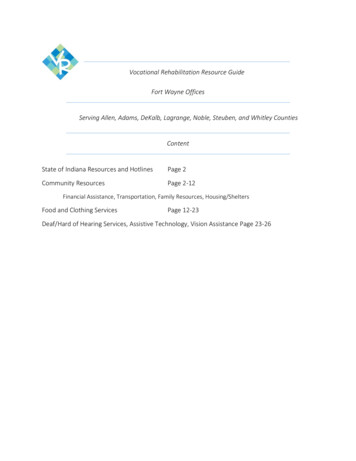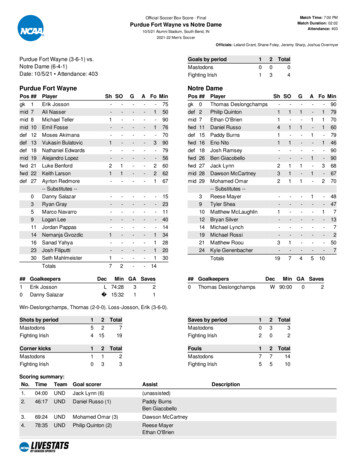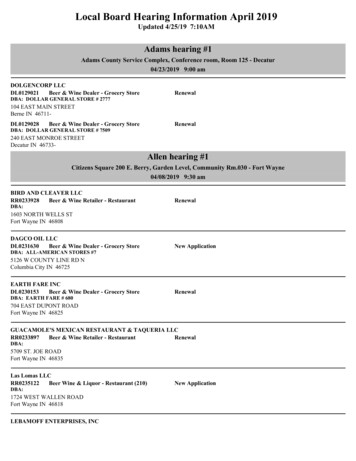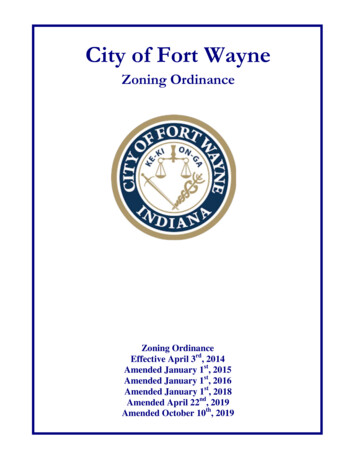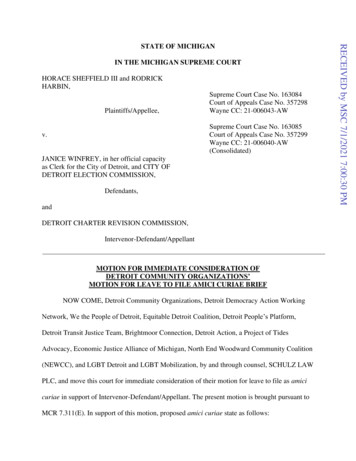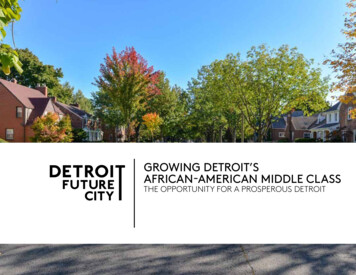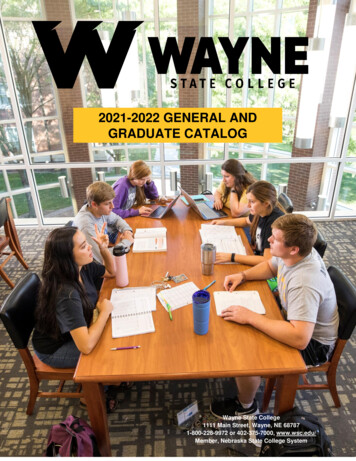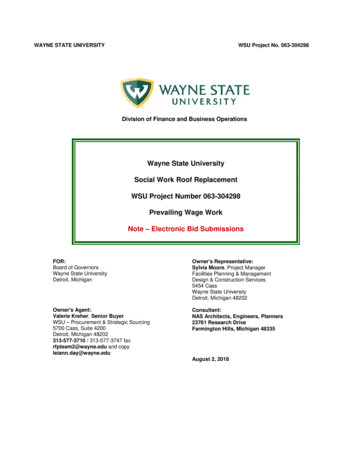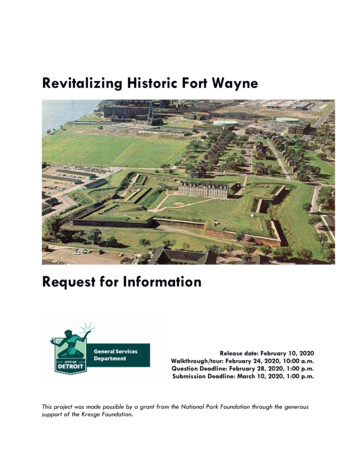
Transcription
Revitalizing Historic Fort WayneRequest for InformationRelease date: February 10, 2020Walkthrough/tour: February 24, 2020, 10:00 a.m.Question Deadline: February 28, 2020, 1:00 p.m.Submission Deadline: March 10, 2020, 1:00 p.m.This project was made possible by a grant from the National Park Foundation through the generoussupport of the Kresge Foundation.
TABLE OF CONTENTSI.Introduction2II.Area Overview3III.Property Description5IV.Program Requirements and Guiding Principles7V.Financial Information9VI.Submission Requirements and Process9VII.Review Process11VIII. Reservation of Rights11IX.11AppendicesI. INTRODUCTIONThe City of Detroit General Services Department is seeking partner entities to help revitalize andactivate Historic Fort Wayne through the rehabilitation and adaptive use of numerous vacantbuildings located on the 78-acre riverfront park property. This Request for Information seeksresponses from public or private entities with the capacity to rehabilitate and occupy or operateone or more presently vacant buildings at Historic Fort Wayne with uses compatible andappropriate in a historic park setting. This RFI is being issued as one component in a broaderrevitalization strategy for Historic Fort Wayne, building off of many years of significantcommunity engagement including the State of Michigan’s 2015 Vision for the Future of HistoricFort Wayne.A former riverfront military facility now owned by the City of Detroit, Historic Fort Waynecontains about 40 major structures including an 1842 star fort, a prehistoric Native Americanburial mound, and numerous vacant buildings that formerly served residential, office, andstorage functions. Located at 6325 West Jefferson Avenue, Historic Fort Wayne sits in the city’sDelray neighborhood in what will soon be a prominent, high-visibility location, adjacent to thefuture site of the Gordie Howe International Bridge entrance plaza.The objectives of this RFI are: Identify and initiate dialogue with interested public or private partner entities—includingnonprofit or for-profit organizations, governmental or quasi-governmental agencies,educational institutions, and individuals—with an interest and the capacity to undertake afeasible and sustainable reuse for buildings at Historic Fort Wayne. Provide an opportunity for evaluation and vetting of the types of uses that may or maynot be appropriate and compatible in a historic park setting.2
Allow prospective partners or developers to identify questions, obstacles, challenges, orother key issues that the City of Detroit must resolve in order to facilitate revitalization ofthe site’s historic assets.Ideal responses will indicate an interest in: Financing and undertaking the historically appropriate rehabilitation of a selectedbuilding or buildings (see formation: Secretary of the Interior’sStandards for Rehabilitation). Drawing increased visitation, as well as public awareness and appreciation, to HistoricFort Wayne, a dynamic and evolving Detroit gateway destination. Enhancing the visitor experience at Historic Fort Wayne and encouraging continuedpublic access and enjoyment of the site by City of Detroit residents and visitors. Achieving financial stability by generating revenue or other resources needed to maintainsubject the subject building (or buildings) and grounds.The City of Detroit welcomes inquiries regarding reuse of any individual vacant building(described in more detail in Section III: Property Description, below), a group of buildings, ora comprehensive plan for the entire site. This Request For Information (RFI) is for informationonly and may be the first of a two phase process. Should the City decide to proceed with aproposal based upon the responses to this RFI, it would be through the issuance of a formalRequest for Qualifications (RFQ). However, no proposal submitted as part of this RFI will bebinding in any way.Responses to this RFI are expected to inform the City of Detroit’s efforts to facilitate newpartnerships, recreational and historical programming, and adaptive uses at Historic Fort Wayne.Historic Fort Wayne Statement of PurposeHistoric Fort Wayne will improve the equity of recreational and cultural opportunities forresidents of Southwest Detroit and the region while exemplifying stewardship of the site’soutstanding historic, cultural, and natural resources for the benefit of future generations.II. AREA OVERVIEWHistoric Fort Wayne is situated upon a riverfront location along West Jefferson Avenue in amixed industrial and residential area in the city’s Delray neighborhood.Proximity to the Gordie Howe International BridgeThe area surrounding Historic Fort Wayne promises to be dramatically altered by theconstruction of the Gordie Howe International Bridge, a development which will provide both3
challenges and opportunities regarding access to Historic Fort Wayne. The Detroit-Windsor tradecorridor is presently the busiest crossing between the two nations; the new bridge will connectDetroit and Windsor by directly linking I-75 with Highway 401 in the Canadian province ofOntario.The Gordie Howe International Bridge is projected to carry an estimated traffic of 12,800passenger cars and 13,500 commercial vehicles on a typical weekday. 1 Local motor vehicleaccess to and from the Gordie Howe International Bridge will be on Campbell Street,approximately one quarter-mile from Historic Fort Wayne; pedestrian and bicycle access will beon Jefferson Avenue, immediately across from the entrance to Historic Fort Wayne.Construction began in late 2018, with completion expected in 2024 (for more information, seethe project website at www.gordiehoweinternationalbridge.com).Fig. 1: Conception of completed Gordie Howe International Bridge. Image: Windsor-Detroit Bridge AuthorityDelray NeighborhoodHistoric Fort Wayne is a landmark of the city’s Delray neighborhood, also in a state of transitiondue to the construction of the Gordie Howe International Bridge. The City of Detroit is presentlyin the midst of a comprehensive planning effort, the Delray Comprehensive NeighborhoodFramework and Economic Development Plan, the goal of which is to create in the Delrayneighborhood “a highly industrialized distribution and logistics hub for the Great Lakes region,while maintaining the existing residential housing stock, improving the quality of life for localresidents, and expanding opportunities for nearby employment.” For a timeline and more1http://www.partnershipborderstudy.com/reports us.asp.4
information on the Delray plan, please see g. 2: Location of Historic Fort Wayne (green boundary) within Delray study area (black boundary). Image: City ofDetroit Planning and Development Department.Adjacent Land UsesImmediate neighbors to Historic Fort Wayne, in addition to the forthcoming Gordie HoweInternational Bridge crossing and plaza, also provide opportunities. The Delray Park DetroitRiver Fishing Access Site, bordering Historic Fort Wayne to the southwest (the two sites arepresently separated by a fence), is owned by DTE Energy and operated under an agreement withthe Michigan Department of Natural Resources. The Fishing Access Site offers a boat launchand fishing area; possible integration of this amenity with Historic Fort Wayne would generateadditional traffic and recreational opportunity. The United States Army Corps of EngineersDetroit District office and boat yard sits along the riverfront to the east and is accessed byeasement through Historic Fort Wayne. To the northeast, privately owned expanses of open land(the Detroit Bulk Storage facility on the site of the former Revere Copper and Brass plant) offerpotential opportunity for further ancillary development in support of uses at Historic Fort Wayne.III. PROPERTY DESCRIPTIONThe City of Detroit acquired Historic Fort Wayne in three phases in 1949, 1971, and 1976,5
through two public benefit conveyance programs for surplus federal property administered by theNational Park Service. Historic Fort Wayne was operated for a time as the Fort Wayne MilitaryMuseum and is now managed by the City of Detroit General Services Department, Parks andRecreation Division. A former United States military reservation, Historic Fort Wayne comprisesa rich and historically significant built environment. The site features, in addition to its namesakemasonry star fort (the only such structure remaining in the Midwest), almost 40 historicstructures of varying scales, time periods, and condition, as well as open spaces including aquarter-mile of riverfront access and a historic “parade ground” area now used as athletic fields.A Native American burial mound, dating from around 750–1150, is part of the property and isfenced off from public access.Fig. 3: Property map with building numbers in yellow. Image: University of Michigan, City of Detroit General ServicesDepartment.6
BuildingsStructures contemplated by this RFI range in size from the two-story, formerly residential,duplexes known as Officers Row and NCO (Noncommissioned Officers) Row, along withsmaller utility and storage buildings and a historic theater, to larger barracks buildings and theformer Post Headquarters.Vacant buildings range in condition from “good” to “threatened,” according to conditionsassessments made by Hamilton Anderson and HR&A Advisors in 2015. This range reflects anassociated level of effort of necessary rehabilitation; all buildings will require a substantial levelof investment (open spaces including the historic parade ground are maintained in goodcondition and will be the subject of further investment by the City of Detroit, continuing thefunction of Historic Fort Wayne as open recreational space).A profile of each building, including interior and exterior photos and site plans (where available),a conditions assessment prepared by SmithGroup in 2003, as well as rough cost estimates forrehabilitation, are included on the project website at www.detroitmi.gov/historicfortwayne/RFI.Please note that although a majority of buildings on the site are vacant, a smaller number remainin active use by the city’s Parks and Recreation Division or are subject to ongoing licenseagreements with existing third party partners including the Detroit Historical Society and theHistoric Fort Wayne Coalition. The General Services Department does not intend to discontinueuses that already exist on the Historic Fort Wayne property. Proposals for any occupied buildingmay only be considered as part of a comprehensive plan for a larger group of buildings or for theentirety of Historic Fort Wayne. Such a proposal is strongly encouraged to include a strategy foraccommodating the continuation of any existing uses (see the project website for moreinformation on occupied buildings and uses).Public Access and VisitationBy the end of 2020, the General Services Department intends to increase the Historic FortWayne hours of operation to facilitate regular public visitation as a city park.At present, access to the site by the public is restricted to organized events (weekend tours,historical events, organized sports, weddings, meetings, etc.) and monitored by 24-hour security,for safety reasons and to prevent vandalism. As the completion of the Gordie Howe InternationalBridge elevates Historic Fort Wayne—already a destination in its own right—to serve as agateway to Detroit and the region, the General Services Department will facilitate greater accessto the property, exploring steps to open the site on a regular or daily basis and broaden its appealto Detroit residents and regional visitors with enhanced opportunities for active and passiverecreation and historical interpretation. This may include increased City of Detroit investment atHistoric Fort Wayne or partnership with other governmental agencies or private or philanthropicentities.In the fiscal year 2018-2019, Historic Fort Wayne saw 31,113 visitors.7
Parking and Non-motorized AccessParking needs are served primarily by a 420-space Visitors Parking Lot at the northern end of the site,with another 138 spaces available on-street at convenient locations throughout Historic Fort Wayne.Additional off-street parking spaces are proposed throughout the site in order to serve new uses andprogramming; however, new parking may be limited by a desire to maintain the historic character of thesite as well as to preserve open space (See https://detroitmi.gov/historicfortwayne : Historic FortWayne Parking Plan).Historic Fort Wayne is presently served by the Detroit Department of Transportation’s Route 30(Livernois) bus route. Routes will be expanded in the coming years as the completed GordieHowe International Bridge draws increased pedestrian and bicycle traffic to the area. Uponcompletion of the bridge, it is anticipated that up to three routes will terminate in close proximityto the entrance to Historic Fort Wayne.The Gordie Howe International Bridge will include dedicated pedestrian and bicycleinfrastructure, allowing non-motorized users to arrive from Canada, with a point of entry alongWest Jefferson Ave. across from Historic Fort Wayne’s main entrance.Historic Fort Wayne will also feature a convenient connection to the Joe Louis Greenway, aplanned biking and walking trail that will extend from the Detroit Riverfront to Highland Park,8
Dearborn, and Hamtramck (for a map and more information, please ces-department/joe-louis-greenway).IV. PROGRAM REQUIREMENTS AND GUIDING PRINCIPLESRevitalization efforts at Historic Fort Wayne are grounded in the 2003 Historic Fort WayneMaster Plan, a 2015 community visioning workshop sponsored by the Michigan EconomicDevelopment Corporation, and a 2019 community and stakeholder outreach effort conducted bythe General Services Department. In general, these planning processes envision Historic FortWayne as a multifaceted, multi-use attraction, simultaneously serving as a destination foroutdoor recreation—both for neighborhood residents as well as those from elsewhere in Detroitand the surrounding area—and as a historic interpretive site enlivened by educational andoperational partnerships with other institutions.The 2003 plan first introduced the strategy of a public-private partnership, with a governmentalentity responsible for programming and operations at the site; ancillary buildings would beleased to compatible public or private (commercial or nonprofit) entities to generate revenue forrehabilitation. Community and stakeholder engagement conducted in 2015 and 2019 identified ageneral consensus of support for a mix of adaptive uses at Historic Fort Wayne, provided thatuses identified will be compatible in a historic park setting and play a supportive role tocontinued historical and recreational use of the property (See our website for informationhttps://detroitmi.gov/historicfortwayne Historic Fort Wayne Master Plan (2003) and See ourwebsite for 2015 community visioning workshop maps; information collected during the 2019outreach opportunities is provided on the main Historic Fort Wayne page.Historic Preservation CovenantThe General Services Department is working to remove deed restrictions within the year fromthe Federal Lands to Parks Program and Historic Surplus Property Program; future developmentwill instead be governed by a historic preservation covenant mandating adherence to theSecretary of the Interior’s Standards for Rehabilitation. Historic preservation will be a guidingprinciple; however, some degree of alteration (including building additions, partial demolition,interior alterations, landscaping, and lighting) may be appropriate to adapt a building to itsproposed new use. Both a draft covenant as well as the Standards are included as an appendix tothe RFI as Appendix E: Draft Historic Preservation Covenant and Appendix F: Secretary ofthe Interior’s Standards for Rehabilitation, respectively.Legal and Regulatory Requirements All properties subject to this RFI are located within the Fort Wayne Historic District,established by City of Detroit Ordinance No. 25-16. All work affecting the exteriorappearance of a resource within the district, including work that would not otherwiserequire a permit such as paint colors and landscaping, must be approved by the City ofDetroit Historic District Commission as described in the Michigan Local Historic DistrictAct (PA 169 of 1970) and Chapter 25 of the City Code.9
Historic Fort Wayne is zoned R1: Single-family Residential District. The GeneralServices Department has proposed a rezoning to PD: Planned Development District,which would allow a broad range of business, residential, and some industrial uses, tofacilitate the revitalization of Historic Fort Wayne. For this reason, respondents maypropose any otherwise legal use of the property, regardless of current zoningclassification. We anticipate that the proposed zoning change will be presented to theDetroit City Council for consideration by mid-2020. For proposals that include a residential use, at least 20% of the units, whether for rent orfor sale, must be affordable to those households earning up to 80% of the area medianincome (AMI). The unit mix and sizes should be supported by market conditions.V. FINANCIAL INFORMATIONIn general, it is envisioned that selected partners will be responsible for a minimum rent based onFair Market Value as determined by the City of Detroit on a building-by-building basis. It isexpected that the Fair Market Value rent will be offset by the level of tenant investment required,which may result in a nominal rental rate. Further, the City of Detroit may consider a discountedrent for partner entities that offer a direct and quantifiable service (such as food and beverageservice, a gift shop, recreational equipment rental, etc.) to Historic Fort Wayne visitors, asdetermined during lease negotiations.Fort Wayne is listed on the National Register of Historic Places and its buildings may be eligiblefor the federal Historic Rehabilitation Tax Credit.Any selected developer will be responsible for all infrastructure costs associated with the project,including but not limited to electrical, gas, street, water, and sewerage. A Phase 1 Environmental SiteAssessment, prepared in 2001, should be considered outdated, but is provided as an appendix to this RFIfor baseline purposes. See our website for information https://detroitmi.gov/historicfortwayneVI. SUBMISSION REQUIREMENTS AND PROCESSResponse FormatWritten responses should address the items below in a clear and concise fashion using a narrativeformat. Site plans or other renderings are not required at this time. Submissions must include acomplete electronic copy in an 8.5x11 PDF format as an attachment. Compelling Narrative of Your ConceptPlease identify the building, buildings, or area in which you are interested; discuss yourvision for adaptive use and highlight how it conforms to the objectives of this RFI.Describe any building alterations or site improvements that will be required to facilitateyour proposed use. If applicable, provide a market overview and market needsassessment.10
Organizational and Financial CapacityProvide an estimated budget and evidence of financial capacity to successfully completethe project. Describe any capital funds, letters of credit, proposed volunteer labor, in-kinddonations, or other sources of support, including any grants or city, state, or federalfinancial incentives to be sought in conjunction with the project. Identify any anticipatedrevenue streams. Describe your qualifications and any relevant experience withrehabilitation or adaptive use projects or a similar type and scale, especially those withhistorical interpretation or outdoor recreation components.Smaller organizations, including volunteer organizations, are encouraged to respond tothis RFI. In some cases, such entities may wish to partner with higher-capacityorganizations in order to create a more competitive proposal. Value-added BenefitsPlease describe any additional forms of value or consideration generated by yourproposal, other than financial, and how they are of benefit to the property, the localcommunity, or the City of Detroit. What direct or indirect benefits will you provide thatwill improve the Historic Fort Wayne experience for City of Detroit residents andvisitors? Will your proposed use create synergy with other (existing or proposed) on-sitemanagement entities or partners? Additional InformationIf desired, please identify any additional information you seek, describe any obstaclesyou see to implementing your proposed use or to a successful revitalization of theproperty in general, or provide any suggestions regarding technical assistance the City ofDetroit could provide to facilitate successful partnerships at Historic Fort Wayne.Submission of ResponsesAll responses must be received by 1:00 p.m. on March 10, 2020, via Oraclewww.detroitmi.gov/supplier open bids.Once received, submitted responses may be made publicly available so that they can serve as ashared resource for the City of Detroit and for the benefit of potential respondents.Questions and Site VisitAny questions regarding this RFI may be submitted by February 28, 2020, at 1:00 p.m., viaOracle www.detroitmi.gov/supplierAnswers to questions will be posted on the Oracle website.Entities interested in responding to this RFI may attend a walkthrough to be held at Historic FortWayne on February 24, 2019 at 10:00 a.m. This session will provide an opportunity to view the11
property and several building interiors. A presentation will be made by City of Detroit staffhighlighting the site’s planning history and the community vision for the area. Although the sitevisit is not required, interested parties are strongly encouraged to attend. An RSVP is appreciatedbut not required; please contact Toni Stewart-Limmitt at limmittl@detroitmi.gov.VII. REVIEW PROCESSSubmissions will be evaluated by a selection committee consisting of City of Detroit staff. TheGeneral Services Department may, at its option, present eligible RFI responses at a publicmeeting prior to making any selection.Submissions will be reviewed according to the following criteria: Compatibility of the proposed use with values of historic preservation, interpretation, andoutdoor recreation as expressed in the Historic Fort Wayne Statement of PurposeCompatibility of the proposed use with community vision as expressed in 2015 and 2019stakeholder engagement effortsAbility of the proposed use to increase visitation or enhance the visitor experience atHistoric Fort WayneFinancial and organizational capacity of the responding entity to undertake a historicallyappropriate rehabilitation of the selected building or buildingsAbility of the proposed use to attain financial sustainabilityVIII. RESERVATION OF RIGHTSThe City of Detroit reserves the right to reject any and all responses or to engage in furtherdiscussion with any or all respondents as it deems is in the best interests of the City.The City of Detroit reserves and may exercise the right to request one or more of the respondentsto provide additional material, clarification, confirmation, or modification of any information inthe submission, and can supplement, amend, substitute, cancel, or otherwise modify this Requestfor Information at any time prior to the selection of one or more developers.In the event that the process outlined in this document does not result in the execution of adefinitive selection, the City of Detroit, at its sole option, may choose to initiate negotiationswith any other qualified developer, open the an RFI process, or pursue any other avenues for theproperty deemed appropriate by the City of Detroit.The City of Detroit reserves the right, in its sole discretion, without liability, to use any or all ofthe RFI responses in its planning efforts and to develop and operate the property, in whole or inpart, outside of the RFI process. The City reserves the right to retain all the materials andinformation, and the ideas and suggestions therein, submitted in response to this RFI. All suchmaterial, information, ideas, and suggestions will become the property of the City.12
The City of Detroit is issuing this RFI solely for information and planning purposes, and this RFIdoes not constitute a solicitation. A response to this notice is not an offer and cannot be acceptedby the City to form a binding contract.Respondents are hereby notified that the City has not fully investigated the environmentalcondition of the Historic Fort Wayne site. Various Federal, State, or other City agencies mayhave information regarding the environmental condition of the site. Each respondent isencouraged to conduct its own due diligence regarding the environmental condition of the site.The City of Detroit makes absolutely no warranty or representation regarding the environmentalcondition of any of the Historic Fort Wayne site discussed within this RFI.IX. APPENDICESA site map and building-by-building profile (photos, description, and conditions assessment,etc.) is available at the project website, formation. Historic Fort Wayne Parking PlanPhase 1 Environmental Site AssessmentHistoric Fort Wayne Master Plan (2003)2015 community visioning workshop mapsDraft Historic Preservation CovenantSecretary of the Interior’s Standards for Rehabilitation13
Revitalizing Historic Fort Wayne. Request for Information . Release date: February 10, 2020. Walkthrough/tour: February 24, 2020, 10:00 a.m. Question Deadline: February 28, 2020, 1:00 p.m. . activate Historic Fort Wayne through the rehabilitation and adaptive use of numerous vacant
